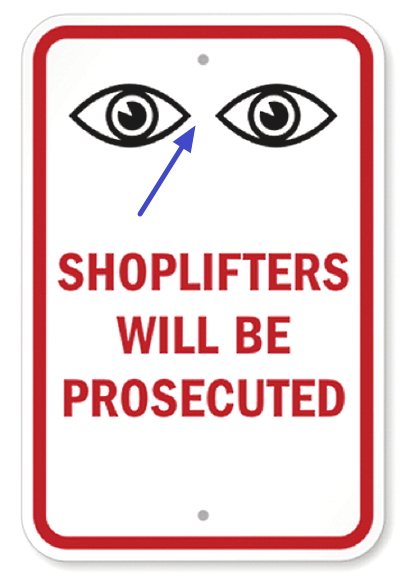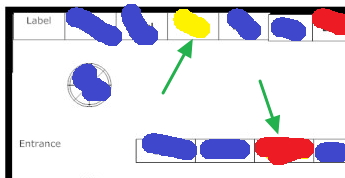
From the results coming through from my clients' stocktakes, it is clear that shoplifting and retail shrinkage, in general, are significant problems facing retailers in 2023. Figures for retail shrinkage in 2022 were already high, with many blaming the impacts of COVID-19. However, emerging figures for 2023 seem to indicate the problem is worsening. Understanding the causes of retail shrinkage and implementing prevention strategies has never been more critical for retailers looking to protect their bottom line.
Major Causes of Retail Shrinkage
Many factors contribute to retail shrinkage, and awareness of these significant causes can help retailers target their prevention efforts.
Shoplifting
Shoplifting, or the theft of merchandise from a store by customers. It is the fastest-growing category. As a punt, it probably is about 35% of your total retail shrinkage. Shoplifters tend to move when the shop is busy. Often, they work alone and look for techniques to avoid detection. Once they find a method that works, they will target that method.
Some ways retailers can deter shoplifting include:
-
High-quality customer service - Attentive employees who greet and assist customers can deter potential shoplifters. I believe that much shoplifting can be stopped by having grandmum stand in front of the shop and greet everyone as they come into the shop.
-
Clear lines of sight - You must always give your staff good stock visibility of your stock.
-
Electronic anti-theft measures - Security gates, tagging merchandise, CCTV cameras, mirrors, etc. Even if they are not activated, their mere presence helps.
-
Signage - Signs warning of video surveillance and prosecution of shoplifters. The best signs have images of eyes, which I discussed here.

-
Secured high-risk items - Keeping expensive or frequently targeted items locked away. Your stocktake figures should be able to identify these items.
Employee Theft
Employee theft accounts are now estimated at about 30% of retail shrinkage. This can include stealing merchandise, giving unauthorized discounts, under-ringing sales, or outright theft of cash.
Retailers can reduce employee theft by:
-
Background checks - Thoroughly screening job candidates for any red flags.
-
Employee training - Comprehensive training on policies, expectations, and consequences.
-
Accountable culture - Emphasizing integrity and deterring temptation.
-
Transparent systems - Restricting access monitoring transactions. If employees cannot get into these systems, they do not know how they work.
-
Hiring - Investing in hiring quality staff and training them thoroughly in policies, loss prevention, and inventory management. A well-crafted resume template is a valuable tool for assessing the skills and expertise of potential candidates. By using templates, companies can more easily identify top talent. Following recruitment, it's equally important to focus on training staff in policies, loss prevention techniques, and inventory management to reduce errors and ensure business success.
-
Frequent auditing - If possible, have every employee responsible for a till.
Return Fraud
Those without a good return fraud will get decimated by this fraud. Here, customers returned stolen merchandise and used fraudulent or stolen receipts. Retailers can prevent return fraud with the following:
-
Receipt requirements - Mandating checks of all receipts used for returns.
-
Camera - Use your camera to match customers to receipts.
-
ID tracking - Recording customer IDs with each return transaction has a significant impact.
Administrative Errors
Human and paperwork errors account are now estimated at about 15-20% of retail shrinkage. Preventing administrative errors involves:
-
Employee - Ensuring staff enter the correct figures into the computer.
-
Goods received - These are matched to the suppliers' invoices.
Vendor Fraud
At around 5% of losses, vendor fraud happens when vendors deliberately short-ship or overcharge retailers. Prevention includes:
-
Checking stock receiving - Invoices should be checked to ensure the quantity matches the invoice. Similarly, that credit for goods going back matches your vendors' figures.
-
Checking prices - Do the invoice price details match what you were told? I have seen invoices with a much higher charge figure than quoted figures.
Damaged/Expired Goods
Damaged merchandise and expired perishable items comprise around 5% of retail shrinkage. This can be minimised through:
-
Employee training - Handling goods properly, ensuring stock in the front window, if in the sun, is rotated.
-
Inventory management - First in, first out stock rotation, monitoring expiry dates.
Audits and Inventory Control
Doing these shows that you care; they also show problems much faster than stocktakes at the end of the year. Use, if possible, use the cyclic stocktaking system in your POS System.
Frequent cycle counts, inventory audits, monitoring stock discrepancies, and keeping inventory organized.
Dedicated Loss Prevention Expert
Getting a knowledgeable loss prevention specialist to check your systems out may pay.
Assessing Current Losses
- This tells you the extent of the problem by quantifying current shrinkage levels and identifying problem areas. Drawing problem planograms in the shop of the problem places helps a lot.

A picture is worth a thousand words.
This image could be a planogram of your shop with your problem areas marked.
Blue = Good
Yellow = Moderate to bad
Red = Very bad
blank = Zero
See how it visually shows the problem areas.
Detail on how to do it are available here.
Continuously Evaluating and Improving
- Regularly reviewing audit data fine-tuning strategies over time.
Conclusion
Retail shrinkage through shoplifting, employee theft, paperwork errors and more continues to be a significant drain for retailers. Implementing the right prevention strategies tailored to your business, training staff thoroughly, leveraging technology and continuously reviewing audit data can help protect your bottom line. With proper vigilance and loss prevention processes, retailers can reduce shrinkage and improve profitability.


